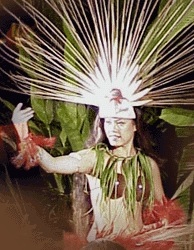the heartbeat of the Hawaiian peolple
 Hawaiianische Luau Tänzerinnen
Hawaiianische Luau Tänzerinnen Hawaiianische Luau Tänzerin
Hawaiianische Luau Tänzerin Beinschmuck der Luau Tänzer
Beinschmuck der Luau Tänzer
`A`a i ka hula, waiho ka hilahila i ka hale.
When one wants to dance the hula, bashfulness should be left at home.E hea i ke kanaka e komo maloko; e hânai ai a hewa ka waha.
Call to the person to enter; feed him until he can take no more.Hô`ale`ale Mânâ i ke kaha o Kaunalewa.
Mânâ ripples over the land of Kaunalewa
(Said of the movements of a dance. A play on `ale`ale (to ripple like water), referring to the gestures of the hands, and lewa (to sway), referring to the movement of the hips.)Hôpoe, ka wahine lewa i ke kai.
Hôpoe, the woman who dances in the sea.
(Hôpoe was a dancer of Kea`au, Puna, in that long ago day when gods mingled with men. Because of her dancing and her kindly nature, Hôpoe was taken by the goddess Hi`iaka to Kaua`i to fetch Lohi`au, the first request Hi`iaka made to Pele was to be kind to her friend, Hôpoe. After a time, when Hi`iaka did not return as expected, Pele in a fit of rage destroyed Hi`iaka's grove and the beloved Hôpoe. The latter was changed into a balancing stone that seemed to dance in the sea.)I le`a ka hula i ka ho`opa`a.
The hula is pleasing because of the drummer.
(The lesser details that one pays little attention to are just as important as the major ones. Although the attention is given to the dancer, the drummer and chanter play an important role in the dance.)Ka `ili`ili hânau o Kôloa; ka nalu ha`i o Kâwâ.
The reproducing pebbles of Kôloa; the breaking surf of Kâwâ.
(In Punalu`u, Ka`û, is a small beach called Kôloa. The pebbles found here were believed to reproduce--the smooth ones being males and the porous ones, females. These were considered the best on the island for hula `ili`ili. Kâwâ is just beyond Kôloa toward Honu`apo.)Ka lehua nene`e o Kâ`ana.
The low-growing lehua of Kâ`ana.
(Refers to Kâ`ana, Moloka`i. Often mentioned in chants of Moloka`i, the lehua of Kâ`ana were loved by the goddess Kapo. Introduced animals destroyed this lehua grove. The first or one of the first hula schools is said to have been located at Kâ`ana.)Kuhi no ka lima, hele no ka maka.
Where the hands move, there let the eyes follow.
(A rule in Hula)Mai pa`a i ka leo, he `ole ka hea mai.
Do not withhold the voice and not call out (a welcome).
(From a powerful chant used in hula schools. One who would like a friendly invitation to come into another's home often.)Moloka`i ku`i lâ`au.
Moloka`i, pounder of medicine.
(The kâhuna of Moloka`i were said to be experts in compounding medicines and poisonous potions. Also, a stick dance bore this name.)Niniu Moloka`i, poahi Lâna`i.
Moloka`i revolves, Lâna`i sways.
(A description of the revolving of the hips and the swaying movements of the hula.)Pa`i ana na pahu a hula le`a; o ka`u hula no kêia.
Let the better-enjoyed hula dancers beat their own drums; this is the hula chant that I know.
(A retort: Let those who claim to know a lot produce their knowledge; this is what I know.)`Unu mai a ho`onu`anu`a ke kilu o Kalama`ula, ho`ole`ale`ale`a i ke kaha o Kaunalewa.
Bring all the kilu for amusement at Kalama`ula to make merry on the field of Kaunalewa.
(To come together for a gay time and bring whatever you have to add to the fun. There is a play on lewa, which refers to the swinging of the hips in hula.)
